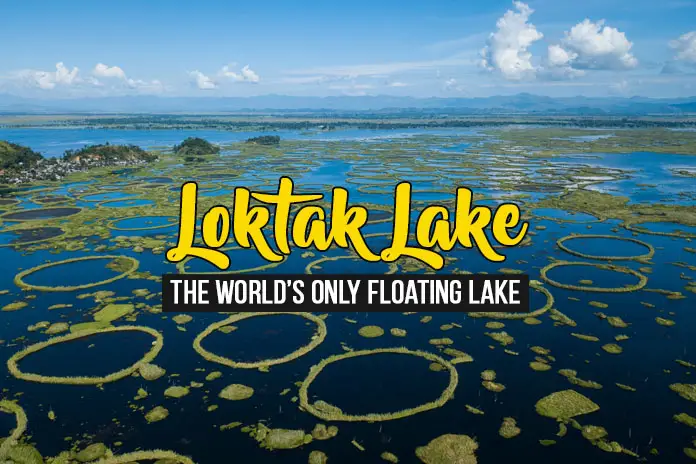Located in the northeastern state of Manipur, Loktak Lake is the largest freshwater lake in Northeast India and is famous for the phumdis floating over it. Loktak Lake is the only Floating lake in the world due to the floating phumdis (heterogeneous mass of vegetation, soil, and organic matters at various stages of decomposition)
The lake is situated in a state where most of the resources remain untapped even today. The beautiful lake is situated at a distance of almost 53 kilometers from Imphal. The mesmerizing lake’s most prominent feature is floating islands. When viewed aerially, the lake seems to be filled up with islands, but in actuality, there are no islands.
Loktak Lake is home to floating islands that house a national park and a school.
The Eco-System of Loktak Lake
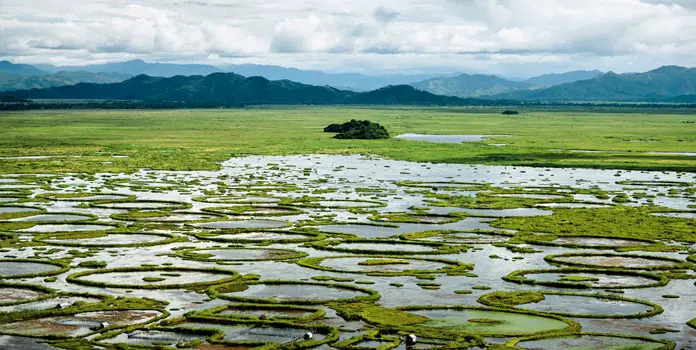
The vibrant eco-system of the floating lake occupies an area or about 240 sq. Kilometers. When witnessed from high altitudes, it looks like the lake has a dotted texture due to numerous ‘small islands’, which in actuality, are known as Phumdis. ‘Phumdis’ are described as the collection of floating masses of vegetation, decomposed soil along with various other forms of organic matter. Phumdis are formed naturally and pile up over several years. Due to the presence of the Phumdis, the livings roots are facilitated to reach the bed of the lake during the dry weather. When monsoon arrives, they re-absorb the nutrients and come to the surface again.
Loktake lake is home to 233 species of aquatic plants, more than 100 species of birds, and 425 species of animals, including the Indian python and sambhar.
Inhabitants
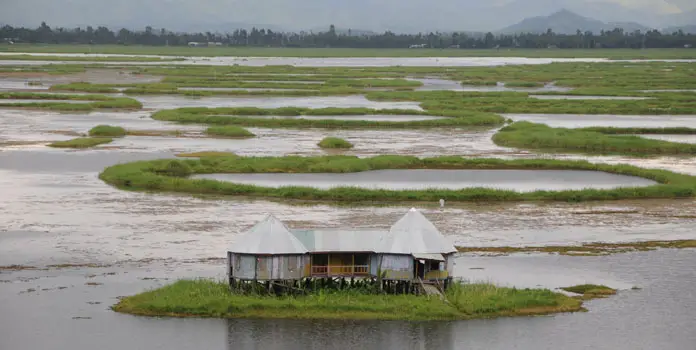
The area is inhabited by locals, who have to build their houses or shelters on the floating island. When the sun sets, the rays falling on the lake make it look picture-perfect, adding to its natural magnificence. The fishermen of the area use boats with oars when they set out to fish, which disturbs the monotony and the silence of the place. They set out early to place fish traps. Canoes, which have been popular for centuries, are used by them to set the stated fish traps. The main occupation of the people residing in the area is fishing, and therefore, the lake serves as a lifeline. Some people depend on the Loktak lake for irrigation, hydel power generation and most importantly, for the supply of fresh water for drinking. There are several huts, built out of rocks, bamboo, rods and metal plates, which act as houses for the fishermen. Another point to keep in mind that India’s first floating school is found in the region.
Varied Species of Loktak Lake
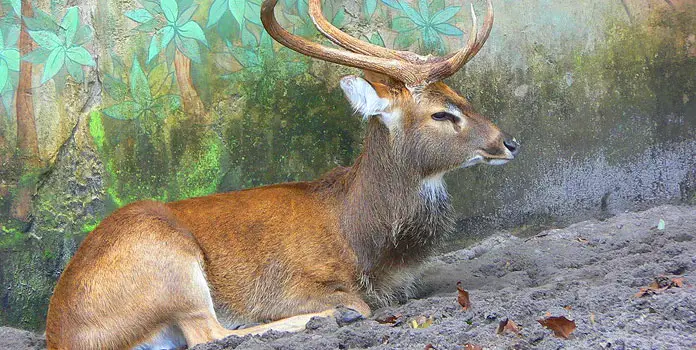
Apart from human beings, the region provides a home to approximately 425 species of animals, more than 100 different species of birds in addition to a remarkable 233 species of aquatic plants. If you are fortunate enough, you might even get to witness the rare ‘Sangai Dancing Deer’ wandering around the phumdis of Loktak Lake. The presence of the Keibul Lamjao National Park is another remarkable feature of the place. It is to be noted that the site is the largest phumdi, covering an area of almost 40 sq. Kilometers and the only floating national park in the whole world.
Issues regarding the excessive growth of Phumdis – Even though the place came to be known because of Phumdis, rapid growth is leading to severe problems. After the construction of the Ithai Hydropower Dam, the water level began to stay risen throughout the year, which led to the growth of Phumdis breaking due to nutrient deficiency.
How to Reach Imphal from Guwahati (or rest of India)
The capital of Manipur, Imphal is around 490 km from Guwahati. The best way to travel Imphal is by air. It’s an hour flight from Guwahati and you can buy a two-way ticket for around INR 2500.
How to Reach Loktak Lake from Imphal
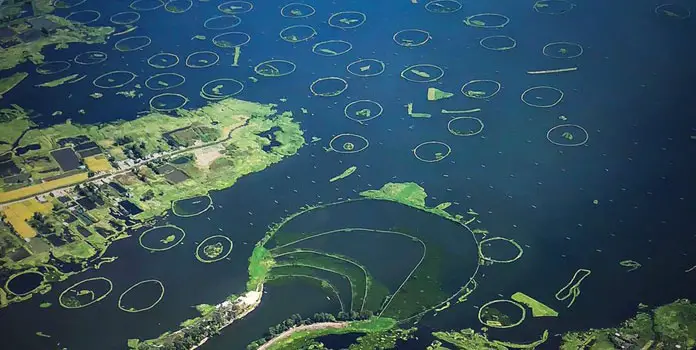
Loktak Lake is situated about 50 km from Imphal. To reach Loktak, you must first take a taxi or a cab from Imphal for Moirang which is 30 km away and costs INR 50 per head. You can find taxis for Loktak at the stand near Jiribam, Imphal market road.
From Moirang one has to go to Thanga which is actually a cluster of small villages situated on the peninsula of the Loktak Lake. The taxi fare is INR 10 per head. From here, the lake can be accessed easily.
Where to Stay near Loktak Lake
- Maipakchao’s Homestay
- Floating homestay: Sangai Moonlight Camping and “Loktak Aqua Inn Floating Restaurant and Homestay”
- Comfortable option: Sendra Park & Resort, a high-end resort with a great view of the lake.
Watch this awesome vlog on Loktak Lake by Hopping Bug
Quick Facts about Loktak Lake
- Location: Moirang, Manipur
- Lake Type: Freshwater (lentic)
- Primary inflows: Manipur river and many small rivulets
- Primary outflows: Through barrage for hydropower generation, irrigation, and water supply
- Catchment area: 980 km2 (380 sq mi)
- Designated: 23 March 1990
- Loktake lake is home to 233 species of aquatic plants, more than 100 species of birds, and 425 species of animals.
- Loktak Lake is home to floating islands that house a national park (Keibul Lamjao National Park) and a school.
- Loktak Lake is said to be the lifeline of Manipur.
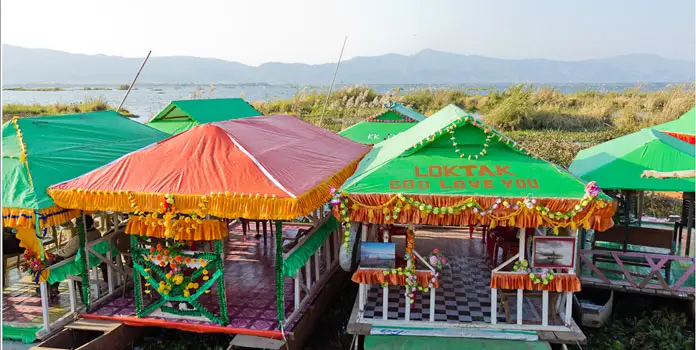
Things to do/Reasons to visit Loktak Lake
- Enjoy the view of this picturesque lake.
- Phumdis: This is a vegetation type which is peculiar and unique to this lake and you will see how the amazing shape and size of this vegetation makes it a wonder of the region
- Loktak Lake boasts of housing the one and only natural floating island situated on a river in the entire world.
- One of the best activities available at this place is boating.
- The Keibul Lamjao National Park is situated on the floating island in the middle of the lake. This makes it the only natural park in the whole world which is situated on a natural floating island on a lake.
- INA Memorial Complex: In the year 1944, the Indian National Army led by Subhas Chandra Bose unfurled the first Indian flag on Indian soil here at Moirang
- Maibam Lokpaching: Popularly known as the Red Hills, this is a pilgrimage site for the Japanese.

FAQs on Loktak Lake
Loktak Lake is famous for “phumdis.“ These circular landmasses are made of vegetation, soil, and organic matter (at different stages of decomposition) that have been thickened into a solid form.
Due to the floating phumdis, this lake is called floating lake. Loktak Lake is home to floating islands that house a national park and a school.
The sangai is an endemic and endangered subspecies of brow-antlered deer found only in Manipur, India. It is also the state animal of Manipur.
The Keibul Lamjao, the only floating national park in the world, is home to the last of the brow-antlered deer, one of the most endangered deer in the world.

